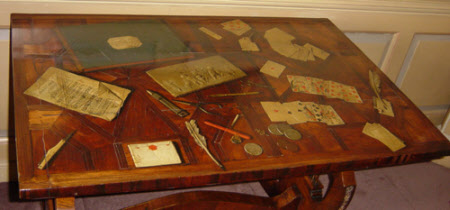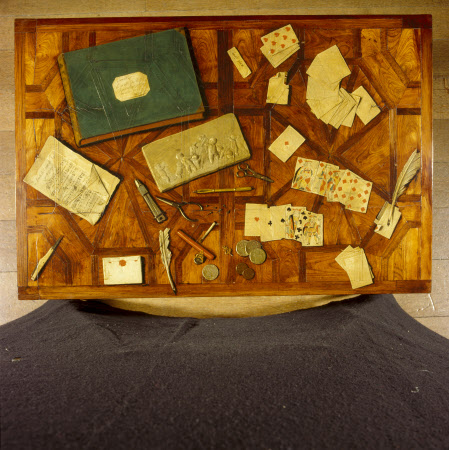Table top
Louis-Léopold Boilly (La Bassée, near Lille 1761 – Paris 1845)
Category
Furniture
Date
1793 (before)
Materials
Oil on rosewood parquetry
Measurements
75 x 112 cm
Place of origin
France
Order this imageCollection
Wimpole, Cambridgeshire
NT 206627.1
Caption
Many useful objects have been discarded on the surface of this unusual side table, including playing cards, coins, a quill pen, a penknife, a pencil, a letter with a red seal, a pair of slender scissors and some pliers, carpet tacks, a folded sheet of music (with an aria from a Belgian opera), a music book and various scraps of paper. However, any guests tempted to tidy the surface or pick up a playing card would soon be surprised, as this unusual table is designed to trick the eye. The table top is simply a very cleverly painted design. There was a long tradition of this type of representation (known in French as trompe l’oeil), and examples can be found dating from classical times onwards. The table was made in France in the late 1700s and painted by Louis-Léopold Boilly (1761–1845), whose father was a furniture- maker. The inclusion of very ordinary objects alongside decorative features, such as a plaster relief depicting children playing with a goat, appears both naturalistic and playful.
Summary
A painted trompe l'oeil table top, signed by Louis-Léopold Boilly (1761 - 1845), before 1793, raised on NT 206627.2 an associated rosewood table base, English, circa 1820. The table-top of rosewood and kingwood veneers arranged in a parquetry pattern, and painted with various items including: - a slip of paper signed 'boilly pinx' - a volume of music bound in green and labelled 'Sonates/et ariette de Mr/Charpentier pour le/clavecin 1774/valseur' - some sheet music entitled '17 Ariette de Zemir et Azor/par Mr Gretry' - a terracotta plaque of putti playing with a goat, after or in the manner of François Duquesnoy (1597-1643) - some silver and copper coins of Louis XV and Louis XVI, one dated 1773 - implements for writing, drawing, and sealing - a sealed letter (face-down, so no name or address visible) - a quantity of playing-cards, two of which have had their sides cut into (for use as tallies of the score?)
Full description
Louis-Léopold Boilly (La Bassée, near Lille 1761 – Paris 1845) was one of the most important and influential painters of everyday life of late eighteenth and early nineteenth-century France. Son to a sculptor in wood, he produced works from the age of 12 or 13. During the late 1770s, under the direction of Dominique Doncre (1743 - 1820), he developed the style of trompe l'oeil (literally, ‘a trick of the eye’), depicting objects in what appear to be three dimensions. Indeed, the term trompe l’oeil was first coined by Boilly for a painting exhibited at the 1800 Salon. There might have been some doubt as to whether the signature on this table top is genuine, since a number of the items represented – Charpentier’s harpsichord sonatas published in 1774, an aria from Zémire et Azor by the Liege-born composter André Gréty (1771/2) and some coins of Louis XV's reign – antedate Boilly’s activity as an artist, but it may be that these – like the clockmaker’s tools – reflect the musical taste, and perhaps even the profession, of the person for whom he painted this table-top. When this table was exhibited at Lille in 2011-12 (see exhibition catalogue Boilly (1761 - 1845), Palais des Beaux Arts de Lille, 4th November 2011 - 6th February 2012), Alastair Laing (then the National Trust’s Curator of Pictures & Sculpture) suggested that this table’s parquetry top might have been supplied by Boilly’s father, since it differs from his other works: a table now in the collection of the Fondation Rau pour le Tiers-Monde, Zurich has a top formed from artist’s board, and the top of a guéridon in the Musée de Lille (ex. cat. no. 42) is made from a piece of paper set into mahogany. Boilly is known to have made at least three other table-tops, but this one is the most elaborate in his oeuvre. The earliest – and simplest – of Boilly’s trompe l’oeil paintings (in the Sterling and Francine Clark Art Institute, Williamstown) has, on the basis of its similarity to the work of Dominique Doncre, Boilly’s tutor, been dated to 1780-5. On the basis of the objects they feature, two of Boilly’s table-tops (one in the Fondation Rau pour le Tiers-Monde, Zurich and the other in the Musée de Lille) are believed to have been painted in, or very soon after, 1792-3, when the First Republic was proclaimed and the French monarchy fell. The Wimpole table-top is thought – on stylistic grounds – to have been painted after the painting of 1780-5 but before the table-tops of 1792-3, and so was described in the Lille exhibition catalogue as having been painted ‘before 1793’. How and when Elsie Bambridge, née Kipling (1896-1976) and her husband George Bambridge (1892-1943) acquired this rare table-top is unclear, but it was first listed in an inventory taken at Wimpole in 1939. (Entry adapted from Boilly (1761 - 1845), Palais des Beaux Arts de Lille, 4th November 2011 - 6th February 2012 exhibition catalogue).
Provenance
Believed to have been purchased by George Bambridge (1892 - 1943) and Elsie Bambridge (1896 - 1976). Listed in the Inventory taken at Wimpole in 1939; and in the Inventory taken in 1965 in Drawing Room No. I (p. 4). The hall and contents were bequeathed to the National Trust in 1976 by Elsie Bambridge.
Marks and inscriptions
Top centre: boilly pinx
Makers and roles
Louis-Léopold Boilly (La Bassée, near Lille 1761 – Paris 1845), painter
Exhibition history
Treasured Possessions from The Renaissance to the Enlightenment, Fitzwilliam Museum, Cambridge, 2015, no.165 Louis-Léopold Boilly, Palais des Beaux Arts de Lille, France , 2011 - 2012
References
Siegfried 1992: Susan L. Siegfried, ‘Boilly and the Frame-up of Trompe l’oeil’, Oxford Art Journal, vol. 15 no.2, 1992, p.29 & fig. 4 Siegfried 1995: Susan L. Siegfried, The Art of Louis-Léopold Boilly Modern Life in Napoleonic France, New Haven & London, 1995 Avery, Calaresu and Laven 2015: Victoria Avery, Melissa Calaresu and Mary Laven (ed.), Treasured Possessions: from the Renaissance to the Enlightenment, The Fitzwilliam Museum, Cambridge, 24 March to 6 September 2015, Cat. 165, Fig. 184, pp.172 Laing 2011: Alastair Laing, ‘Dessus de table en trompe l’oeil’, in Annie Scottez-De Wambrenchies and Florence Raymond (ed.), Boilly (1761-1845), Palais de Beaux Arts de Lille, cat. no. 164, 2011, 238



